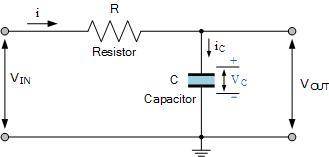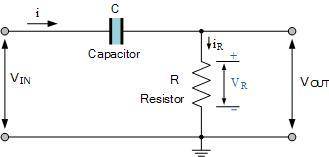For an RC integrator circuit, the input signal is applied to the resistance with the output taken across the capacitor, then VOUT equals VC. As the capacitor is a frequency dependant element, the amount of charge that is established across the plates is equal to the time domain integral of the current. That is it takes a certain amount of time for the capacitor to fully charge as the capacitor can not charge instantaneously only charge exponentially.
Therefore the capacitor current can be written as:
his basic equation above of iC = C(dVc/dt) can also be expressed as the instantaneous rate of change of charge, Q with respect to time giving us the following standard equation of: iC = dQ/dt where the charge Q = C x Vc, that is capacitance times voltage.
The rate at which the capacitor charges (or discharges) is directly proportional to the amount of the resistance and capacitance giving the time constant of the circuit. Thus the time constant of a RC integrator circuit is the time interval that equals the product of R and C.
Since capacitance is equal to Q/Vc where electrical charge, Q is the flow of a current (i) over time (t), that is the product of i x t in coulombs, and from Ohms law we know that voltage (V) is equal to i x R, substituting these into the equation for the RC time constant gives:
We have seen here that the RC integrator is basically a series RC low-pass filter circuit which when a step voltage pulse is applied to its input produces an output that is proportional to the integral of its input. This produces a standard equation of: Vo = ∫Vidt where Vi is the signal fed to the integrator and Vo is the integrated output signal.
The integration of the input step function produces an output that resembles a triangular ramp function with an amplitude smaller than that of the original pulse input with the amount of attenuation being determined by the time constant. Thus the shape of the output waveform depends on the relationship between the time constant of the circuit and the frequency (period) of the input pulse.
By connecting two RC integrator circuits together in parallel has the effect of a double integration on the input pulse. The result of this double integration is that the first integrator circuit converts the step voltage pulse into a triangular waveform and the second integrator circuit converts the triangular waveform shape by rounding off the points of the triangular waveform producing a sine wave output waveform with a greatly reduced amplitude.
RC Differentiator
For a passive RC differentiator circuit, the input is connected to a capacitor while the output voltage is taken from across a resistance being the exact opposite to the RC Integrator Circuit.
A passive RC differentiator is nothing more than a capacitance in series with a resistance, that is a frequency dependentTherefore the capacitor current can be written as:
device which has reactance in series with a fixed resistance (the opposite to an integrator). Just like the integrator circuit, the output voltage depends on the circuits RC time constant and input frequency.
Thus at low input frequencies the reactance, XC of the capacitor is high blocking any d.c. voltage or slowly varying input signals. While at high input frequencies the capacitors reactance is low allowing rapidly varying pulses to pass directly from the input to the output.
This is because the ratio of the capacitive reactance (XC) to resistance (R) is different for different frequencies and the lower the frequency the less output. So for a given time constant, as the frequency of the input pulses increases, the output pulses more and more resemble the input pulses in shape.
We saw this effect in our tutorial about Passive High Pass Filters and if the input signal is a sine wave, an rc differentiator will simply act as a simple high pass filter (HPF) with a cut-off or corner frequency that corresponds to the RC time constant (tau, τ) of the series network.
Thus when fed with a pure sine wave an RC differentiator circuit acts as a simple passive high pass filter due to the standard capacitive reactance formula of XC = 1/(2πƒC).
But a simple RC network can also be configured to perform differentiation of the input signal. We know from previous tutorials that the current through a capacitor is a complex exponential given by: iC = C(dVc/dt). The rate at which the capacitor charges (or discharges) is directly proportional to the amount of resistance and capacitance giving the time constant of the circuit. Thus the time constant of a RC differentiator circuit is the time interval that equals the product of R and C. Consider the basic RC series circuit below.
Explanation:



